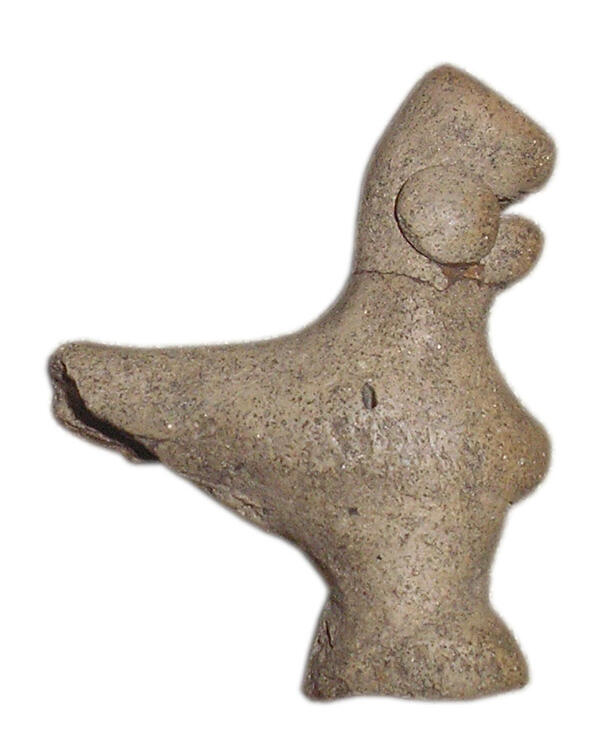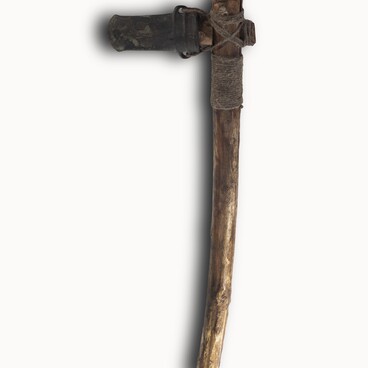The Kursk Regional Museum of Archaeology houses a clay whistle, which was accidentally discovered by the museum staff S.A. Ermakova in 2000, 300 meters from the left bank of the river Psyol, in a newly ploughed plot of land in the village of Krupets of the Belovo district, in the Kursk region.
The toy in the form of a bird on a short cone-shaped leg was made of clay and after firing it received a beige tint. There are no traces of paint or glaze. The height of the whistle is 45 mm, the length from the muzzle to the breast is 37 mm. On the head of the bird there is a crest with no glaze or painting, and round pebble eyes. The foot has a lens-shaped depression at the base for stability. On the right side there is a small play hole pierced, and a whistle is placed in the tail. Back in ancient times, the lower wall of the mouthpiece of the whistle hole was chipped off, after which the silenced whistle ended up in the village dump.
According to Vladimir Povetkin, director of the “Center of Musical Antiquities of Veliky Novgorod”, it was possible to produce only two sounds from the whistle. One by simply blowing into the main hole, the second by blocking the side hole. It was possible to establish that the trills of the whistle consisted of the G of the second octave. Vladimir Povetkin has established that the Kursk toy is similar to the two whistles found in Novgorod region, and the techniques of manufacture and appearance are so similar that the expert put forward an assumption that they were made in the same workshop.
The first of the Novgorod toys was found near the district center of Lubytino (the Novgorod region) by local residents. The second whistle was discovered during archaeological excavations of Novgorod in 1972 in the city layer of the second quarter of the 15th century, which also allowed to date the rest of the whistles of this group.
The Novgorod toy could get to the Kursk region through trade, which at that time connected different parts of the Russian land. The bird whistle found in the village of Krupets is the oldest of all whistling clay toys found on the territory of the Kursk region.
The toy in the form of a bird on a short cone-shaped leg was made of clay and after firing it received a beige tint. There are no traces of paint or glaze. The height of the whistle is 45 mm, the length from the muzzle to the breast is 37 mm. On the head of the bird there is a crest with no glaze or painting, and round pebble eyes. The foot has a lens-shaped depression at the base for stability. On the right side there is a small play hole pierced, and a whistle is placed in the tail. Back in ancient times, the lower wall of the mouthpiece of the whistle hole was chipped off, after which the silenced whistle ended up in the village dump.
According to Vladimir Povetkin, director of the “Center of Musical Antiquities of Veliky Novgorod”, it was possible to produce only two sounds from the whistle. One by simply blowing into the main hole, the second by blocking the side hole. It was possible to establish that the trills of the whistle consisted of the G of the second octave. Vladimir Povetkin has established that the Kursk toy is similar to the two whistles found in Novgorod region, and the techniques of manufacture and appearance are so similar that the expert put forward an assumption that they were made in the same workshop.
The first of the Novgorod toys was found near the district center of Lubytino (the Novgorod region) by local residents. The second whistle was discovered during archaeological excavations of Novgorod in 1972 in the city layer of the second quarter of the 15th century, which also allowed to date the rest of the whistles of this group.
The Novgorod toy could get to the Kursk region through trade, which at that time connected different parts of the Russian land. The bird whistle found in the village of Krupets is the oldest of all whistling clay toys found on the territory of the Kursk region.



